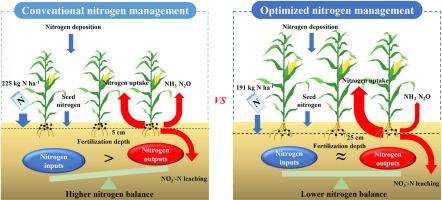Reducing nitrogen application through deep placement to optimize the nitrogen balance in a dryland maize cropping system
IF 10
1区 环境科学与生态学
Q1 ENGINEERING, ENVIRONMENTAL
引用次数: 0
Abstract
Estimating nitrogen (N) balance in croplands is critical for optimizing N management and promoting sustainable agriculture. Deepening N placement while reducing application rates offers a promising strategy to improve N balance, but remains underrepresented in field studies, especially in semi-arid regions. Here, we used a two-year field experiment combining three N rates [conventional (225 kg N ha−1) and two reduced rates (191 and 158 kg N ha−1, representing 15 % and 30 % reductions)] with four placement depths (5, 15, 25, and 35 cm) to assess their interactive effects on N balance in dryland maize systems. We quantified N inputs (seed, fertilization, atmospheric deposition), outputs (crop uptake, NH3 volatilization, N2O emissions, and leaching), and soil N retention over two growing seasons with contrasting rainfall patterns. Reducing N inputs generally decreased gaseous N losses, crop N uptake, and grain yield, ultimately lowering overall N balance. Regardless of application rate, deep N placement significantly reduced gaseous N losses and improved crop N uptake compared to shallow placement (5 cm), effectively compensating for yield losses due to reduced N application. A 15 % N reduction combined with 25 cm placement resulted in the lowest N balance and highest economic return by minimizing both gaseous and hydrological N losses. This combination also increased crop N uptake and grain yield by 13.8 % and 12.5 %, respectively, relative to the conventional practice. Moreover, deep placement with reduced N demonstrated greater resilience to extreme rainfall, helping to stabilize N balance. These findings highlight the potential of optimized placement depth to reduce N use while enhancing environmental and economic benefits.


通过深埋减少氮肥以优化旱地玉米种植系统氮平衡
估算农田氮素平衡对优化农田氮素管理和促进农业可持续发展具有重要意义。在减少施氮量的同时增加施氮量是改善氮素平衡的有效策略,但在田间研究中仍未得到充分体现,特别是在半干旱地区。本研究采用为期两年的田间试验,结合3种施氮量[常规施氮量225 kg N ha - 1)和2种施氮量(191和158 kg N ha - 1,分别减少15%和30%)]和4种施氮深度(5、15、25和35 cm),评估它们对旱地玉米系统氮平衡的交互影响。在不同的降雨模式下,我们量化了两个生长季节的N输入(种子、施肥、大气沉降)、输出(作物吸收、NH3挥发、N2O排放和淋失)和土壤N保持。减少氮素投入通常会降低气态氮损失、作物氮素吸收和粮食产量,最终降低总体氮素平衡。无论施氮量如何,与浅施(5厘米)相比,深施氮显著减少了气态氮的损失,提高了作物对氮的吸收,有效地补偿了因施氮量减少而造成的产量损失。减少15%的氮素,加上25厘米的放置,通过减少气体和水文氮素损失,达到最低的氮素平衡和最高的经济效益。与常规做法相比,该组合还使作物吸氮量和粮食产量分别提高了13.8%和12.5%。此外,低氮深埋对极端降雨表现出更强的恢复能力,有助于稳定氮平衡。这些发现强调了优化放置深度的潜力,以减少氮的使用,同时提高环境和经济效益。
本文章由计算机程序翻译,如有差异,请以英文原文为准。
求助全文
约1分钟内获得全文
求助全文
来源期刊

Journal of Cleaner Production
环境科学-工程:环境
CiteScore
20.40
自引率
9.00%
发文量
4720
审稿时长
111 days
期刊介绍:
The Journal of Cleaner Production is an international, transdisciplinary journal that addresses and discusses theoretical and practical Cleaner Production, Environmental, and Sustainability issues. It aims to help societies become more sustainable by focusing on the concept of 'Cleaner Production', which aims at preventing waste production and increasing efficiencies in energy, water, resources, and human capital use. The journal serves as a platform for corporations, governments, education institutions, regions, and societies to engage in discussions and research related to Cleaner Production, environmental, and sustainability practices.
 求助内容:
求助内容: 应助结果提醒方式:
应助结果提醒方式:


